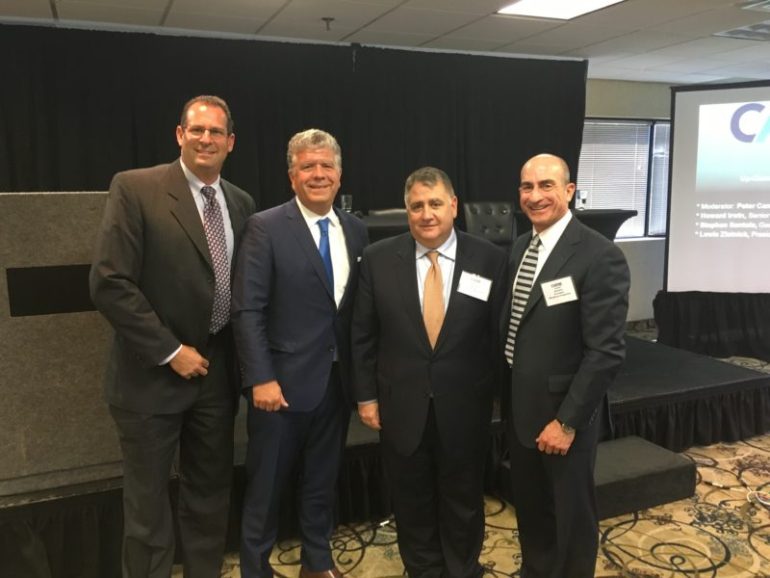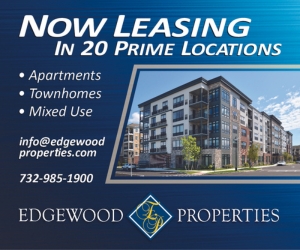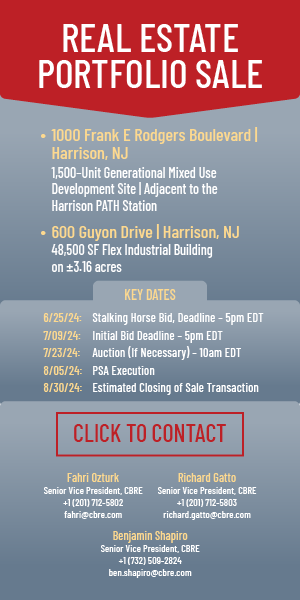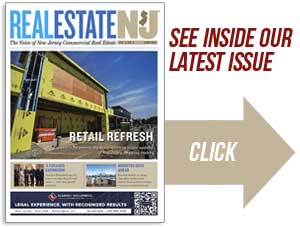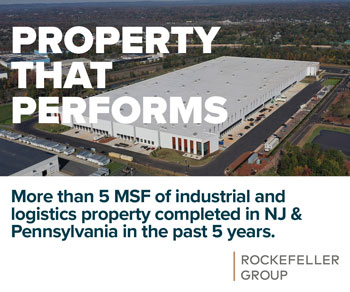Left to right: Woodmont Properties Senior Vice President of Construction Howard Irwin, Woodmont Properties Executive Vice President and General Counsel Stephen Santola, Metuchen Mayor Peter Cammarano, Woodmont Properties President Lewis Zlotnick after speaking at the Middlesex-Somerset CRE Summit — Courtesy: Beckerman Public Relations
By Joshua Burd
If the first 40 years of Woodmont Properties were about becoming an institution in New Jersey’s real estate sector, the last 10 have been about ushering in a new era for the Fairfield-based firm.
Look no further than the developer’s multifamily portfolio: In 2007, Woodmont started work on a roughly 200-unit community that marked its first foray into the apartment sector.
Today, it has a collection of more than 2,000 apartments across 10 properties in the region — and a pipeline that could bring that number to 4,000 by 2020.
As part of a recent panel discussion, Woodmont President Lewis Zlotnick shared the formula behind the firm’s transformation “from good to great” under CEO Eric Witmondt, son of founder Donald Witmondt. The first thing Eric Witmondt did starting around 2000 was to “(get) the right people on the bus,” Zlotnick said, bringing in top executives who could support its move into multifamily while continuing its growth in sectors such as industrial.
The other key was finding joint venture partners in other developers, as Woodmont did in Morristown nearly a decade ago.
“(That) really put us on the map in terms of a downtown redevelopment company and helped solidify our track record in New Jersey as a transit-oriented development builder,” Zlotnick said. “It was people, then it became the processes and the execution — and our ability, because of our track record, to raise capital.”
Zlotnick spoke last week during the second annual Middlesex-Somerset CRE Summit at the APA Hotel in Woodbridge. Hosted by CapRate Events, the conference included a Q&A session with top Woodmont executives that focused on the growth of the development firm and its recent work in Central Jersey.
All told, the company has grown from 10 employees when Zlotnick started in the early 1990s to more than 130 today, he said. Back then, Woodmont was “primarily building homes and had a nice office and industrial portfolio,” while having $100 million in assets under management.
That figure has since grown to $600 million. And along with multifamily, the firm has focused on the booming warehouse and distribution market through the formation of Woodmont Industrial Partners in 2011.
“The formula is a little bit different than our apartment equation,” Zlotnick said of the industrial platform. “With the apartment equation, we buy and hold, primarily with our own money and friends and family capital.
“Our industrial portfolio is about 2 million square feet right now and our equation is to buy, add value and sell. And we primarily do that with capital investors, and a lot of these properties that we acquire are driven by the brokerage community.”
Last week’s panel was moderated by Metuchen Mayor Peter Cammarano, whose borough is the site of Woodmont’s newest transit-oriented apartment and retail project. That paved the way for a discussion that focused on everything from demographic trends to finding the right match in town hall.
Finding the right location
Stephen Santola, Woodmont’s executive vice president and general counsel, said that 10 or 12 years ago, local governments had stymied new multifamily construction across the state. So if a community was willing to approve a new project, “you could build an apartment community almost anywhere and lease it.”
That’s no longer the case, he said. It’s why Woodmont now focuses on “two buckets” of projects — those in downtown, transit-centric locations and infill, standalone projects with a high level of amenities.
“And I think now, between communities recognizing the importance of it, the millennials coming of age and the need for affordable housing, you’re seeing much more acceptability from communities,” Santola said. “So now, all of a sudden, where you choose to build and what you choose to build becomes important.”
Equally important, he said, the firm doesn’t want to “swim upstream” — meaning it looks for willing partners among local leaders who won’t abandon a project under pressure from a vocal minority.
“Your community is one stop down the train line — we couldn’t be happier there,” Santola told Cammarano. “And I have to say, Metuchen delivered all the way through. They were tough, they wanted what they wanted, but they were always fair, picked up the phone. … We have an open communication back and forth, and that’s really, really important.”
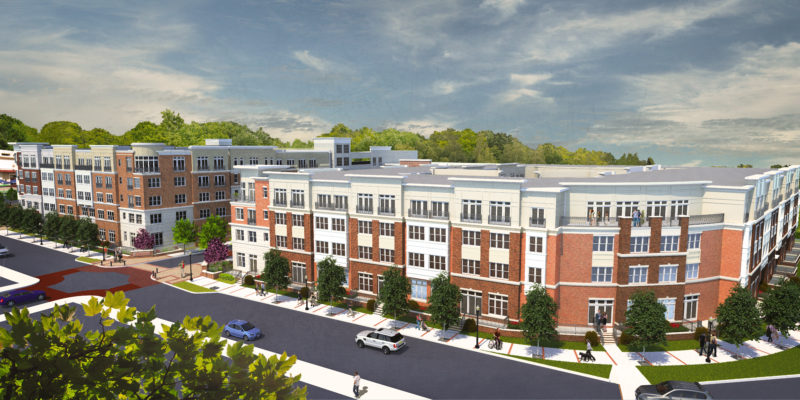
The challenges of building in an urban environment
Santola outlined three challenges that developers face in urban locations. One is that “any time you’re going to dig a hole near a train station, you’re going to find something that you didn’t expect to find,” whether it’s chemicals, waste or other materials that might date back decades.
The other hurdles in downtowns can include trying to assemble a site from different lots and then attempting to build a project without disrupting nearby residents and businesses. Community members are used to their routines, he said, so “you need to make sure that as you’re doing that, you disrupt it in a friendly and cooperative way and in the best way that you can.”
Howard Irwin, Woodmont’s senior vice president of construction, added that establishing relationships with elected leaders and public safety officials is key, especially given the need to bring large trucks and construction equipment to a development site. Developers should also be ready to deal with challenges related to infrastructure, he said.
“Every time we start a job in a downtown environment, the assumption is that, of everything that’s drawn on the site plan, 50 percent of it is going to be changed because of unknown surprises,” Irwin said, later adding, “so you have to be prepared just to deal with it and your schedule has to accommodate the need to react — and your budget.”
How to make transit-oriented development successful
Santola said that, “once you’re in that market and you’re close to the train station, it is a little easier to make it happen. What we focus on at that point is really quality management and really quality amenities.”
For Woodmont, that can mean visiting other luxury properties in the region and taking the best of what works — from amenities to light fixtures to carpeting.
“We’re borrowing from what we’re seeing out there,” Santola said. “So that’s where you want to be. Because the location sells itself, you need to make sure your parking works and then you need to build something really cool that people want to live in.”
As an example of how to succeed in a lesser-known market, Zlotnick pointed to one of New Jersey’s biggest development success stories from the past decade.
“If you look at Morristown 10, 15 years ago, nobody went to Morristown,” he said. “And we were fortunate we were able to do three high-profile transit-oriented developments in Morristown, and we think that it contributed to changing the face of Morristown.
“It’s now a place where people want to go, where people want to socialize. There are about 36 restaurants in town, there are theaters … so it has a vibrancy and life of its own.”
Zlotnick added that, “once you locate people who are living there and have that walkability,” that can unlock a downtown’s potential. And Woodmont’s project will be supported by other development in Metuchen, including a new retail property nearby that will include a Whole Foods.
“This is just the beginning of the morph or change that’s going to happen in Metuchen the way in happened in Morristown,” Zlotnick said. “So we’re excited to be a part of it and be on the doorstep to help create that change.”

